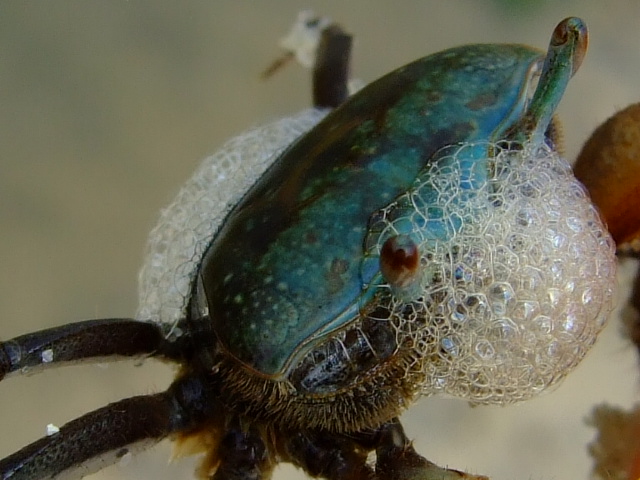People have observed lots of crab species with bubbles of foam around their mouths. Frothing at the mouth is often a dangerous sign in humans and other animals so extrapolating this to crabs Is reasonable. But human anatomy is very different from crustacean anatomy. Foaming in crabs isn’t always deadly though at times it is. It all depends on how long the crab has been out of the water.

Table of Contents
Why do crabs foam?
Crabs produce bubbles primarily to keep their gills moist. Like other crustaceans and fish, crabs breathe through their gills. However, unlike most fish, crabs don’t immediately die once you take them out of the water. Foaming in crabs is frequently observed when they’re on dry land. Foaming is just an indication that the crab is breathing air instead of water.
How crabs breathe underwater
In the water, crabs draw in water through their abdomens. This water is then pumped over the crab’s gills near the mouth. Gills extract dissolved oxygen from the water via diffusion. The oxygen diffuses further into surrounding blood vessels which distribute it to the rest of the crab’s body.
Simultaneously, carbon dioxide is excreted by diffusing out of the surrounding blood vessels and into the water flowing out of the gills. Both gases dissolve in and out of the water along a concentration gradient (i.e. there is more carbon dioxide and less oxygen in the crab blood around the gills compared to the surrounding water, so each gas flows from where it’s most abundant to where it is least abundant.)
How crabs breathe on land
On land, crabs are forced to breathe air. This air still has to be pumped over the gills in order to be absorbed into the bloodstream. Only a handful of species of land crabs that actually have a dual circulation system that employs both lungs and gills are exempt from this. Nevertheless, most crab species only rely on gills for breathing. Oxygen is absorbed along the gill membranes while carbon dioxide is likewise expelled.
It is the pumping of air across the gills that causes foaming in crabs. As air flows over the moist gills, bubbles are formed, resulting in a foaming effect. The gills have to remain moist in order for crabs to breathe. If the gills dry out, the crab is unable to breathe and dies.
Mud crabs can survive out of the water as long as their gills remain moist though they don’t have to be completely submerged. Other crab species can survive out of water for any length of time, from a day or two to only a few hours. It all depends on the natural adaptations of the crab species in question.
What does it mean when a living crab produces bubbles?
A crab producing bubbles means it’s just breathing. The color of the bubbles is what really matters. Whitish, colorless, or near-colorless bubbles are ok signs. Brown bubbles, however, indicate a problem. A crab blowing brown bubbles is often a preamble to death.
How bad can foaming in crabs get?
An unhealthy bubble color is often an indication that a crab is injured or has an infection. By the time you see the brown bubbles, however, it’s too late. Most pet crab owners have reported their crabs dying soon after bubbling so always keep them near water.
What should you do when your crab is foaming?
You should get your crab near a water source as soon as you spot it foaming. Things can only get worse going forward. Aquatic species will need to be submerged. Don’t do the same for any no-aquatic species, however. Full immersion in water might just kill them.
The water you use is also important. Don’t use tap water. It is toxic to saltwater crabs. Add some table salt to it first.
You should also frequently change out the water in your tank. In the absence of a water circulation system, waste products like nitrates tend to accumulate in the water and turn it toxic. This can give your crabs an infection or force them to abandon the tank in search of a less polluted environment.
How to prevent foaming in crabs
- Keep your crabs near a saline water source, even the non-aquatic ones.
- Use saltwater, not freshwater.
- Manage crab numbers. When there are too many crabs in a tank, the weaker ones are forced out. Maintaining a sustainable population eliminates excessive competition.
- Frequently change out the water in your tank to prevent waste buildup and keep the environment your crabs live in relatively clean.
- Maintain optimum water temperature in your tank. Temperatures below 60º F (15º C) are too cold for comfort while temperatures above 90º F (32º C) are lethal. Staying away from either extreme is a good practice though you can go lower for cold water crabs.